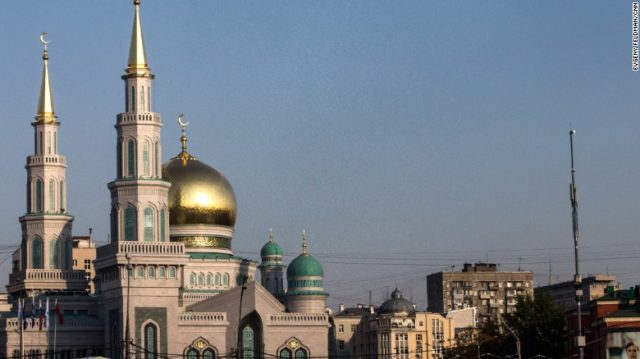
Muslim Migrants Become More Religious After Arriving in Moscow
Publication: Eurasia Daily Monitor Volume: 15 Issue: 44
By:

The Muslim population of the Russian capital has grown dramatically in recent years, with the arrival in the 1990s of North Caucasians fleeing from violence in their home areas and of Central Asians and Azerbaijanis in the 2000s seeking work. Some estimate the total number of Muslims in the capital and its suburbs at as many as three million people, or nearly one in every three—up from 60,000 at the end of Soviet times. This has both frightened and angered many ethnic Russians, who view this as a threat to the Russianness of Moscow (see EDM, October 17, 2013). But it has also transformed those who are part of this Islamic community, leading many of its members to become more committed Muslims than they were before arriving (Fergana News, March 14).
Indeed, according to Dmitry Oparin, a sociologist at the Higher School of Economics who specializes in this community, for many in this larger group “it is easier to be a Muslim in Moscow than in Central Asia.” Although, he pointed out, the meaning of “being a Muslim” varies widely from being a follower of the faith to a broader identification, often far more important than ethnicity or citizenship. In an interview with Fergana News journalist Yekaterina Ivashenko, he discussed the history of this community and its current state, one that he suggests will play a major role in defining what it means to be a Muslim in Russia and the former Soviet space more generally (Fergana News, March 14).
Muslims have resided in Moscow since the time of the Golden Horde. But at the end of the imperial period, they were still a small community, with only two mosques, dominated almost exclusively by highly educated and often wealthy Tatars from Gorky and Ryazan rather than Kazan, Oparin said. After the revolution, this community was nearly wiped out. “In the 1930s, the mosque on Bolshaya Tatarskaya was closed and its imam shot; and the remaining Sobornaya mosque was called by the Muslims of the city ‘the Tatar home,’ ” because it provided far more than religious instruction to the Tatars living in the city, Oparin noted. It was a social and community center, and its traditions have despite all the changes continued to inform Muslim religious life there.
After World War II, the influx of people from Central Asia and Azerbaijan, most of whom were students or members of the national intellectual elites, challenged the dominance of the Tatars in the Moscow Muslim community; but it did not end it, the Moscow scholar said. Some of the new arrivals were alienated by the Tatar mullahs, and it is likely that more of them shifted their identities away from Islam than might otherwise have become the case. But after 1991, the massive arrival of Muslims from the North Caucasus and then Central Asia and Azerbaijan succeeded in undermining Tatar dominance.
On the one hand, the mosques, although the mullahs were still mostly Tatar in background, began using Russian as the language in their services, thus unifying the umma (Muslim community) under that international language. And on the other, Oparin continued, many of the members of these diasporas opened dozens of prayer rooms and converted nominally public facilities like restaurants and clubs into centers of Muslim instruction. This trend especially picked up as the Muslim diasporas began to form residential ghettos. It was further fueled by the Russian authorities’ refusal to increase the number of officially registered mosques in the city—there are still only five in the capital.
As a result, the researcher said, “many migrants from abroad became more religious” than they had been at home and came to understand Islam more broadly than their national communities had permitted. Some of them became radicals, but many simply shifted their dominant identities away from Soviet-imposed ethnic divisions into new and broader religious ones. That has happened not only because “many Moscow imams are well-educated people and represent so-called intellectual Islam,” but also because many unofficial leaders in the prayer rooms are students and immigrants from the Middle East who know Arabic and themselves identify as Muslims rather than as members of particular nations.
Many of the new arrivals turn to the mosque or the prayer hall not for religious reasons but as a community center and mutual assistance organization. However, over time, many are drawn into religious services and activities. The mullahs and imams promote that by offering everything from kindergartens to boxing clubs; and “therefore,” Oparin argued, for the new arrivals, “it is easier to be a Muslim in Moscow than in their motherlands.”
All this has frightened many Russians, the scholar contended; but Muscovites are not as intolerant toward Muslims as many think. Instead, they are intolerant to other cultures, often more opposed to North Caucasians than to Central Asians or Muslims as such. “One must not forget that the Russian milieu is intolerant as a whole” because “we have lost the habit of communicating with others” and it does not matter much who these “others” are defined as. But one thing is clear, Oparin declared: “one cannot promote ethnic tolerance by itself; one can only promote tolerance in general.” Trying to do otherwise will fail.
Given the rising number of people with Muslim backgrounds in the Russian capital and the ever-increasing share of them who are not only practicing but convinced believers, the Russian government is going to have to promote such tolerance. Otherwise, Russia is likely to face a bleak future in which increasingly religious Orthodox square off against increasingly religious Muslims. And the spark could ignite in a place most Russians cannot imagine that would be possible—their own capital city.



